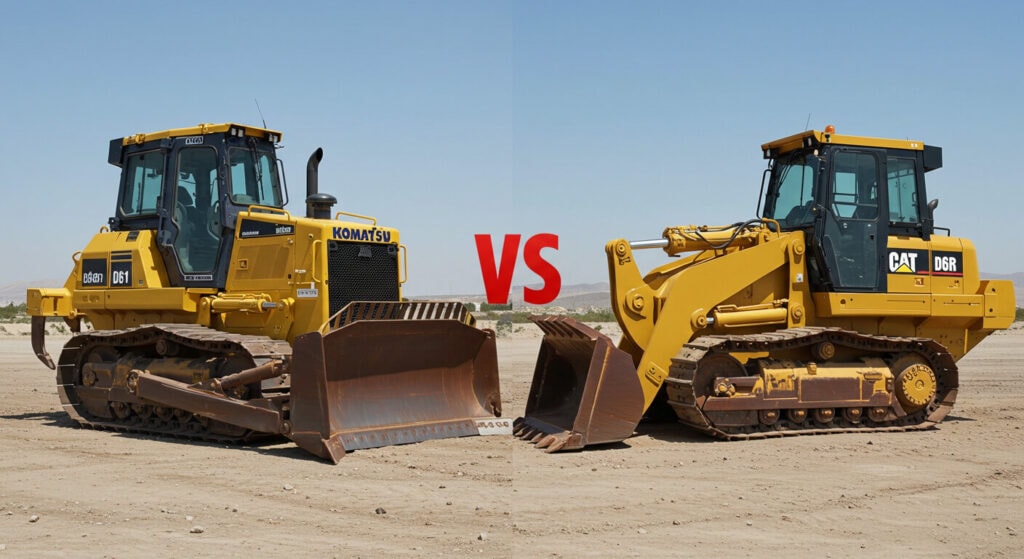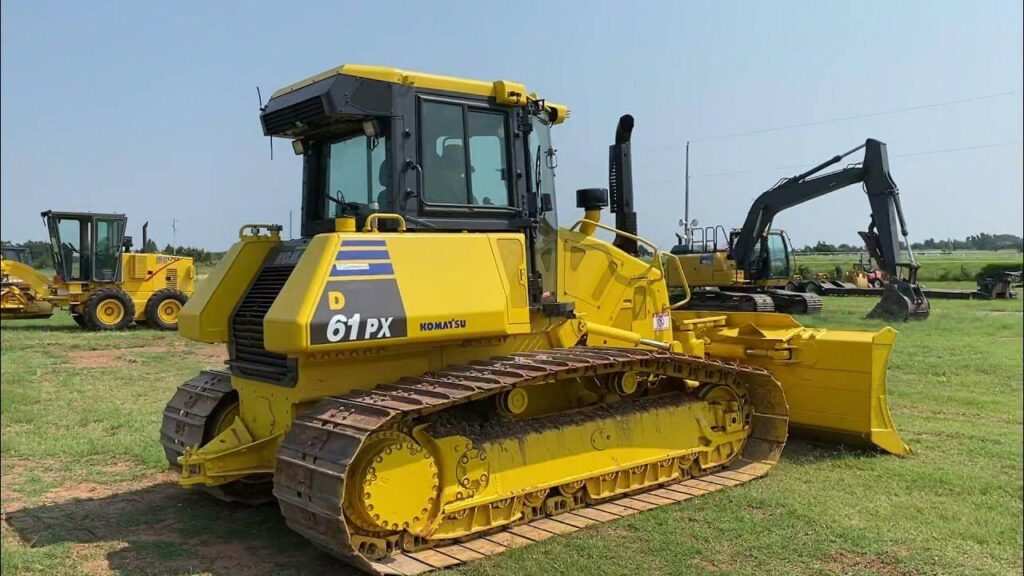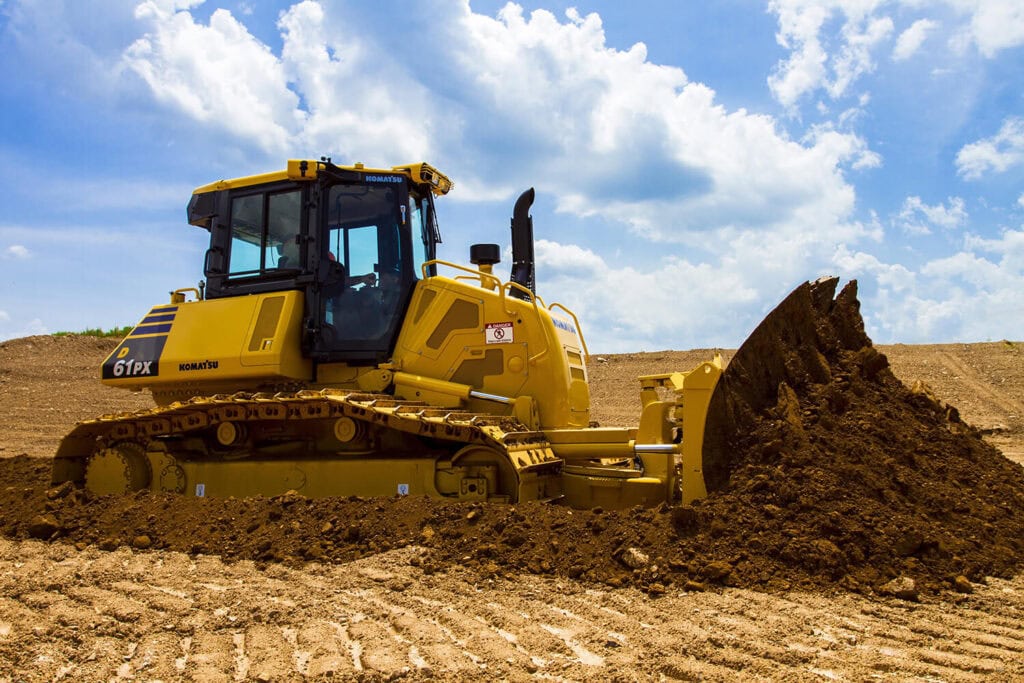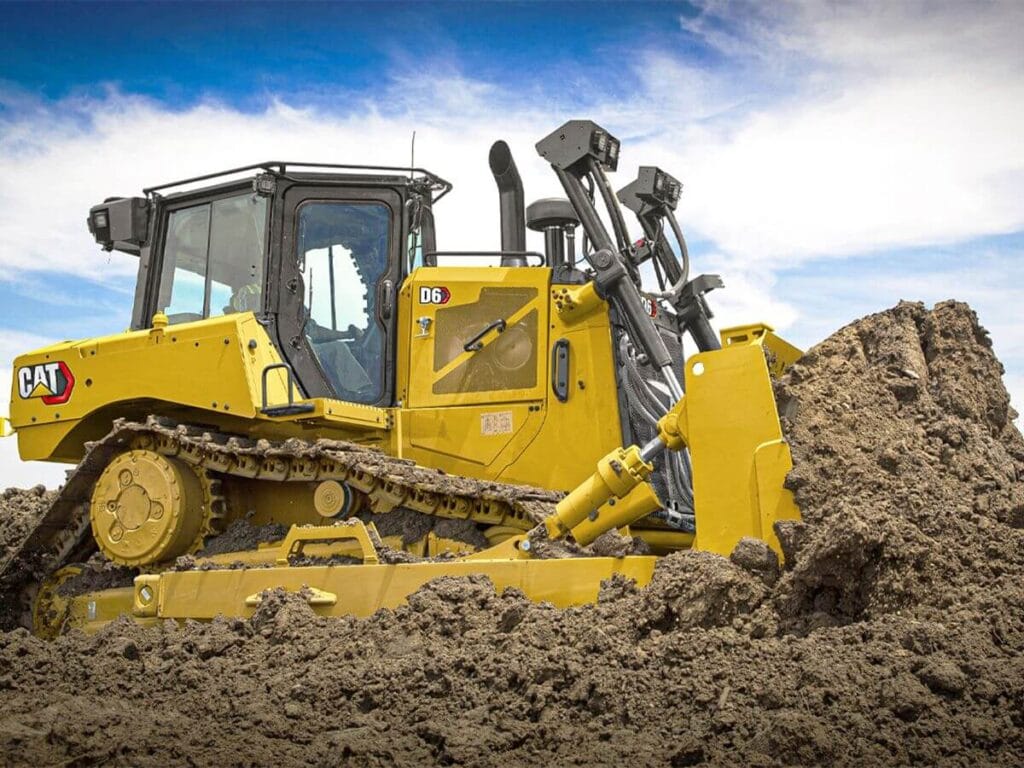Viele Verbraucher sind gezwungen, zwischen dem Komatsu D61 gegen Cat D6 zu wählen, zwei hervorragende Auswahlmöglichkeiten für mittelgroße Dehre. Da Auftragnehmer in der ganzen Welt beide Maschinen vertrauen, ist es schwierig zu bestimmen, ob man tatsächlich überlegene Leistung, Kraftstoffeffizienz und Gesamtrendite für Investitionen bietet.
Die Auswahl des falschen Dockers kann zu mehr Ausfallzeiten, kostspieligen Wartung, verringerten Bewertungsgeschwindigkeit und höherem Kraftstoffverbrauch führen. Jede Arbeitsstunde ist wichtig, während sie an den wichtigsten Straßenbau- oder Erdbewegungsprojekten arbeiten. Sie benötigen einen Dozer, der die langfristige Rentabilität und Zuverlässigkeit sowie die Erfüllung der Aufgabenanforderungen unterstützt.
Wir haben den Vergleich in wichtige Aspekte wie Motorleistung, Kraftstoffeffizienz, Klingenkontrolle, Technologie, Komfort und Wiederverkaufswert unterteilt, um eine fundierte Auswahl zu treffen.

✅ 1. Motorleistung & Leistung
Die Motorleistung ist einer der wichtigsten Faktoren, die bei der Bewertung der verwendeten Bulldozer berücksichtigt werden müssen. Der Motor einer Maschine beeinflusst die Langlebigkeit, die Kraftstoffeffizienz und die allgemeine Betriebseffizienz sowie die Bestimmung der Leistungsleistung. Zwei bekannte Modelle in der mittelgroßen Dozerklasse sind die Komatsu D61 und die CAT D6, die beide starke Leistungsausgaben und einzigartige technische Konzepte aufweisen.
Der Komatsu SAA6D107E-3-Motor, der den Komatsu D61 versorgt, produziert 168 PS (125 kW). Dieser 6-Zylinder-Turbomotor ist für die Zuverlässigkeit bei gemeinsamen Einstufungen und erdbewegten Aufgaben ausgelegt und erzeugt eine konstante Drehmomentleistung. Das leistungsstarke Power-to-Gewicht-Verhältnis und das Betriebsgewicht von 17.738 kg 39.099 Pfund machen es zu einem effektiven Werkzeug für die Vorbereitung des Standorts für die Feinbestimmung und zur Vorbereitung mit mittlerer Duty. Unter unterschiedlichen Belastungen garantiert Komatsus hoch entwickelte Motorkontrolle eine glattere Gasreaktion und verringert die Kraftstoffspitzen.
Im Gegensatz dazu liefert der starkere CAT C9.3B -Motor in der Katze D6 215 PS (161 kW). Das ACERT -Design dieses Motors verbessert die Leistung unter höheren Arbeitsbelastungen und erhöht die Verbrennungseffizienz. Das Arbeitsgewicht des D6 von 22.978 kg von 50.650 Pfund macht es perfekt, um mehr Döckungsjobs zu besteuern, darunter das Schieben schwerer Gegenstände, das Löschen von Land und die Baustraßen. Die Maschine kann aufgrund ihres höheren maximalen Drehmoments von 849 lb-ft leicht härteres Gelände und steilerer Gradienten navigieren, was größer ist als der 577 lb-ft des D61.
Der CAT D6 hat aufgrund des spürbaren Unterschieds in der Leistung und des Drehmoments einen Vorteil bei kraftintensiven Aktivitäten. Für Auftragnehmer, die die Genauigkeit der Genauigkeit und den Kraftstoffverbrauch über die Rohfestigkeit schätzen, wäre der Komatsu D61 eine überlegene Option. Am Ende stützen sich welche dieser beiden Modelle, die Sie wählen, auf die Anforderungen Ihrer regulären Baustelle, des Geländes und der Art der Anhänge, die Sie anwenden möchten.
| Spezifikation | Butsu D61 | Katze D6 |
|---|
| Motormodell | SAA6D107E-3 | C9.3b |
| Nettospannung | 168 PS | 215 PS |
| Betriebsgewicht | 39.099 lbs | 50.650 lbs |
| Maximales Drehmoment | 577 lb-ft | 849 lb-ft |

✅ 2. Kraftstoffeffizienz & Öko -Leistung
Jeder Eigentümer von Schwermaschinen muss die Kraftstoffeffizienz berücksichtigen, insbesondere wenn die Betriebskosten einen direkten Einfluss auf die Rentabilität haben. In die Komatsu D61 und CAT D6 wurden fortschrittliche Kraftstoffsparetechnologie aufgenommen, um den Kraftstoffverbrauch und die Umweltauswirkungen zu senken, ohne die betriebliche Wirksamkeit zu beeinträchtigen.
Der Komatsu D61 unterstützt sein Öko-Performance-Profil mit einer Reihe von Funktionen. Um einen saubereren Abgassendurchgang zu gewährleisten, verfügt der Tier 4 -Finale -Motor über einen Komatsu -Diesel -Partikelfilter (KDPF), der Partikelschadstoffe sammelt. Durch das automatische Ausschalten des Motors nach einer vorgegebenen Zeitspanne reduziert die Funktion des automatischen Leerlaufs in den Maschinen -Leerlaufzeiten den Kraftstoffverbrauch erheblich. Dies ist besonders nützlich auf überfüllten Baustellen, an denen Ausrüstung häufig zwischen den Arbeitsplätzen anhält. Abhängig von der Topographie und Intensität des Betriebs verwendet der Komatsu D61 typischerweise 8,5 Gallonen Kraftstoff pro Stunde.
Die Katze D6 hingegen erreicht eine noch größere Kraftstoffeffizienz. Mit Hilfe des ECO -Modus von Cat, der die Motordrehzahl automatisch verringert, wenn die Nachfrage minimal ist, wird der Kraftstoffverbrauch stark reduziert, ohne die Leistung zu beeinträchtigen. Darüber hinaus ist das fortschrittliche Antriebssystem von Cat so konzipiert, dass die Stromversorgung reibungslos überträgt, wodurch der Kraftstoffabfall während des Verlags von Zahnrädern oder bei teilweise beladenem Verschiebung verschoben wird. All diese Eigenschaften arbeiten zusammen, um den Kraftstoffverbrauch im Vergleich zu früheren Katzenmodellen um 20% zu verringern. Die Katze D6 gehört zu den Kraftstoff-effizientesten Dedeln in seiner Klasse und verwendet durchschnittlich 7,2 Liter Diesel pro Stunde, während sie im ECO-Modus arbeiten.
Although both vehicles satisfy the strict Tier 4 Final emissions regulations, CAT has a small advantage in terms of long-term fuel savings due to its further improvements. For companies with many locations or full-day shifts, this might result in yearly savings of thousands of dollars.
| Feature | Butsu D61 | Katze D6 |
|---|
| Fuel-saving Mode | Auto Idle Shutdown | Eco Mode |
| Engine Technology | Tier 4 Final | Tier 4 Final + ACERT |
| Average Fuel Consumption | ~8.5 L/hr | ~7.2 L/hr (Eco Mode) |

✅ 3. Blade Control & Intelligente Funktionen
Die Art und Weise, wie Dishers die Vorbereitung und eine präzise Einstufung vor Ort durchführen, wurde durch Smart Machine -Technologie vollständig verändert. Sowohl Caterpillar als auch Komatsu haben erhebliche Investitionen in die Schaffung automatisierter Blattsteuerungssysteme getätigt, die die Präzision verbessern, die Ermüdung der Betreiber verringern und die Abschlusszeiten des Projekts beschleunigen.
Das exklusive Intelligent Machine Control -System (IMC) von Komatsu ist ein Merkmal des D61. Selbst auf schwierigem Gelände kann der Betreiber dank dieser integrierten Technologie, die die Klingenerhebung und Neigungsänderungen automatisiert, eine konsistente Bewertungstiefe beibehalten. Darüber hinaus verfügt das IMC -System mit Merkmalen wie Hubschichtregelung und minimaler Entfernungsregelung, die die Aufrechterhaltung der Ausführungsoberflächenstandards und zur Verhinderung der Überkinne unterstützen. Durch drastisch reduzieren die Anzahl der erforderlichen Pässe drastisch und spart Zeit- und Arbeitskosten für Auftragnehmer, die sich auf eine Geldbörse und die Vorbereitung der Grundlage spezialisiert haben.
Die CAT D6 hingegen hat eine Katzengrade mit Steigungsassistent und kann mit GPS-basierten 3D-Systemen eingerichtet werden. Diese Eigenschaften ermöglichen vollständig autonome Klingenbewegungen in komplizierten Geländemodellen und bieten dem Bediener Echtzeit-Feedback. Abhängig von Ihren Betriebsanforderungen kann das D6-System später oder fabrikinstalliert hinzugefügt werden, was Flexibilität bietet. Das Leitfaden für die Steigung ist besonders hilfreich für Entwässerungs- und Straßenbildern, da die Bediener die Zielwinkel mit geringen Eingaben aufrechterhalten können.
Beide Geräte verfügen über automatische Klingenmodi, um die Genauigkeit der Sortierung und die GPS -Kompatibilität zu verbessern. Für groß angelegte Projekte, die präzise Höhenzuordnung und Steigungsübergänge erfordern, bieten die 3D-Funktionen von Cat eine größere Vielseitigkeit. Ihre Entscheidung kann je nach Workflow durch das intelligentere System beeinflusst werden, einschließlich der Frage, ob Sie die Nivellierung der Website oder die endgültige Einstufung priorisieren.
| Blattsteuerungssystem | Komatsu D61 IMC | Cat D6 -Gradkontrolle |
|---|
| Basis -Autoblattmodus | Ja | Ja |
| GPS -Kompatibilität | Fabrik integriert | Fabrik- oder Nachrüstoption |
| Zusätzliche Hilfe | Hubschichtregelung | Hangassistent, Klasse 3D |

✅ 4.. Unterwagendesign & Traktion
Da es einen direkten Einfluss auf Traktion, Stabilität, Flotation und langfristige Haltbarkeit auf eine Vielzahl von Geländetypen hat, ist die Fahrwerk eines der wichtigsten strukturellen Elemente eines Bulldozers. Obwohl sowohl die Katze D6 als auch der Komatsu D61 hoch entwickelte Fahrwerksysteme haben, sind ihre Designs auf unterschiedliche Leistungsziele zugeschnitten.
Es gibt verschiedene Variationen der Unterharriage des Komatsu D61 (LGP) des niedrigen Drucks (LGP). In weichem, schlammigem oder ungleichmäßigem Gelände minimiert dieses breitere Spur -Design die Bodenstörung durch gleichmäßigeres Gewicht. Es ist eine großartige Option für Aufgaben wie die endgültige Einstufung, das Straßengebäude und den Deponienbetrieb. Darüber hinaus oszillieren Equalizer -Balken auf Komatsus Unterstiegshilfe bei der Erhaltung des Bodenkontakts auf ungleichmäßigem Gelände, Verbesserung der Traktion und der Bewertung der Genauigkeit. Darüber hinaus umfasst das Unternehmen Komatsu Plus-Fahrwerkstechnologie, was die langfristigen Wartungskosten senkt, indem die Lebensdauer durch rotierende Buchungssysteme und Hochleistungsverbindungsbaugruppen verlängert werden.
Andererseits verfügt die Katze D6 über ein sehr erfinderisches und anpassungsfähiges Katze erhöhtes Kraftwerks -Design. Durch die Erhöhung der endgültigen Laufwerke aus dem Aufprallweg durch Schocklasten auf Bodenebene verbessert dieses Design den Schutz des Antriebsstrangs und verringert den Verschleiß. Das Systemonetm-Fahrwerk, das für Selbstausrichtung, glattere Fahrten und eine längere Lebensdauer in harten Umgebungen ausgelegt ist, ist eine Option für den D6. Diese Konfiguration eignet sich perfekt für Flotten mit hoher Nutzung und Bediener, die in felsigen oder abrasiven Bodeneinstellungen arbeiten, da sie auch die Anpassungs- und Wartungsverfahren für die Spurspannung vereinfacht.
The Komatsu D61 LGP variation might function better if you frequently work with loose soils, wetlands, or precise grading. However, the raised sprocket and SystemOne undercarriage of the CAT D6 offer better durability and less service downtime for long-hour shifts, rough terrain, and heavy-duty sleeping.
| Feature | Butsu D61 | Katze D6 |
|---|
| Undercarriage Type | LGP / Standard | Elevated Sprocket / SystemOne™ |
| Track Width (LGP) | Up to 36 inches | Up to 30 inches |
| Ground Pressure (LGP) | ~5.7 psi | ~6.0 psi |
| Design Advantage | Better flotation | Greater component protection |

✅ 5. Operator Comfort & Taxi -Ergonomie
Insbesondere für langfristige Projekte ist Bedienerkomfort für Maschinenkontrolle, Sicherheit und Effizienz von Baustellen von entscheidender Bedeutung. Sowohl die CAT D6 als auch die Komatsu D61 haben erhebliche Investitionen in die Entwicklung von Taxis getätigt, die das Situationsbewusstsein verbessern und die Müdigkeit verringern.
Die Komatsu D61 -Kabine ist bekannt für seine komfortable Bedieneroberfläche, niedrige Rauschisolierung und eine breite Sichtbarkeit. Die Kabine verfügt über einen riesigen 7-Zoll-Farbmonitor mit integrierter Diagnose, einen verstellbaren Luftaufhängungsitz im hohen Rücken und einfache Joystick-Steuerelemente. Selbst unter herausfordernden Bedingungen ist die Klimakontrolle effektiv und hoch entwickelte Taxi-Mount-Dämpfungstechnologien verringern die Vibrationsniveau. Darüber hinaus können noch weniger erfahrene Arbeitnehmer Maschinen bedienen, dank Komatsus optimiertes Dashboard -Arrangement, was perfekt für die Flottenflexibilität geeignet ist.
Die Katze D6 erhöht die Bar für Komfort und technologische Integration. Es verfügt über ein geräumiges Operator-Cockpit mit Sitzgedächtnisfunktionen, beweglichen Armlehnen und verbessertem 360-Grad-Anblick. Das 10-Zoll-Touchscreen-Panel verfügt über mehrere Anzeigeeinstellungen, darunter als Bedienerpräferenzen, Maschinendiagnose und Echtzeit-Gradsteuer-Visuals. Darüber hinaus verfügt Cat über Bluetooth -Konnektivität, automatisiertes Klimamanagement und sogar anpassbare Joystick -Einstellungen, um Benutzerpräferenzen zu berücksichtigen. Die ausgefeilte Isolierung und Kabinenentwicklung von Cat sind auch für die Ruhe der Kabine verantwortlich, selbst wenn der Motor mit hoher Geschwindigkeit läuft.
Obwohl beide Maschinen großen Komfort bieten, bietet die CAT D6 einen klaren Vorteil, wenn Sie nach einem digital integrierten Erlebnis mit einstellbaren Bedienereinstellungen und dem interface-reichen Betrieb suchen. Trotzdem ist der Komatsu D61 immer noch eine gute Option für Betreiber, die die Funktionalität und die Benutzerfreundlichkeit schätzen.
| Feature | Butsu D61 | Katze D6 |
|---|
| Sitztyp | Luftverlust | Einstellbar mit Speicher |
| Überwachen Sie die Größe | 7-Zoll-LCD | 10-Zoll-HD-Touchscreen |
| Bedienelemente | Joystick | Joystick mit anpassbarem Layout |
| Geräuschpegel | Niedrig | Sehr niedrig (fortgeschrittene Isolation) |

✅ 6. Preisgestaltung, Wertbehebung & Wiederverkauf
Der Gesamtbesitzwert der schweren Geräte sollte durch Kombination der Kaufkosten, laufenden Ausgaben und dem Wiederverkaufswert festgelegt werden. Aufgrund ihrer starken Nachfrage nach sekundärem Markt und bekannten Marken haben die Komatsu D61 und CAT D6 beide hohe Restwerte. Ihre Lebensdauer und ihre Preisgestaltung unterscheiden sich jedoch.
Auf dem neuen oder gebrauchten Markt ist der Komatsu D61 häufig zu vernünftigem Preis. Es bietet Käufern, die eine Flotte mit einem knappen Budget entwickeln oder die kurzfristige Kapitalrendite optimieren möchten. Darüber hinaus bietet Komatsu in mehreren Bereichen häufig wettbewerbsfähige Komponentenpreise und längere Standardgarantien an. D61 -Modelle sind erschwinglicher und leichter auf dem Gebrauchtmaschinenmarkt zu finden, das ausländische Käufer und kleine Auftragnehmer anspricht.
Die Katze D6 hingegen ist vor und nach dem Verkauf teurer. Sein robustes Wertbetrieb und das weltweite Händler -Support -Netzwerk, das auch nach starker Nutzung höhere Wiederverkaufspreise garantiert, basieren diese Prämie. Aufgrund des weit verbreiteten Bewusstseins der Katzenmarke sind Importeure in Lateinamerika, Afrika und Südostasien - die Maschinenzuverlässigkeit und den Markeneindruck von entscheidender Bedeutung sind - aus zweiter Hand D6 -Einheiten ausgewählt. Darüber hinaus hilft die Produkt -LinkTM -Telematik von Cat bei der Aufführung genauer Wartungsaufzeichnungen, die die Attraktivität eines Fahrzeugs für den Wiederverkauf verbessern können.
In conclusion, Caterpillar gives better long-term value, whereas Komatsu offers more affordable ownership. The length of use, your cash flow plan, and your future intentions for fleet renewal or selling may all influence your choice.
| Cost Factor | Butsu D61 | Katze D6 |
|---|
| Average Used Price | $90,000 – $120,000 | $120,000 – $160,000 |
| Resale Value After 5 Years | ~60% | ~70% |
| Maintenance Cost | Moderate | Slightly Higher |
| Global Resale Demand | Medium | High |

✅ Conclusion: Komatsu D61 vs CAT D6? Which Bulldozer Is Best for Your Business?
Ihre Baustellenanforderungen, finanzielle Überlegungen und die Markentreue werden letztendlich bestimmen, welche der Komatsu D61 und CAT D6 für Sie am besten geeignet ist. Der Komatsu D61 ist ein guter Kauf, wenn Sie nach einem zuverlässigen, preisgünstigen Dozer mit starken Leistung, einfach zu bedienenden Kontrollen und einer hervorragenden Kraftstoffeffizienz suchen-insbesondere für die Feinbestimmung, die Landschaftsgestaltung oder die Vorbereitung der allgemeinen Standort. Die CAT D6 ist jedoch eine erstklassige Wahl, wenn Sie eine leistungsstarke Maschine benötigen, die anspruchsvolle Aufgaben mit modernster Technologie, hervorragender Blattkontrolle und erhöhtem Wiederverkaufswert erledigen kann.
Mit einer dieser Maschinen, die die besten in ihrer Klasse sind, werden Sie nichts falsch machen. Das Geheimnis der Optimierung von Leistung und Rentabilität besteht jedoch darin, Ihre Maschine mit Ihrer Arbeitsbelastung anzupassen.
